Key takeaways:
- Python’s simplicity and readability make it an excellent choice for automation, allowing beginners to easily start automating tasks.
- Utilizing essential libraries like Pandas, Selenium, and PyAutoGUI enhances automation capabilities, allowing users to streamline processes and manage data efficiently.
- Effective automation scripting requires clear comments, breaking tasks into manageable steps, and implementing error handling to avoid failures.
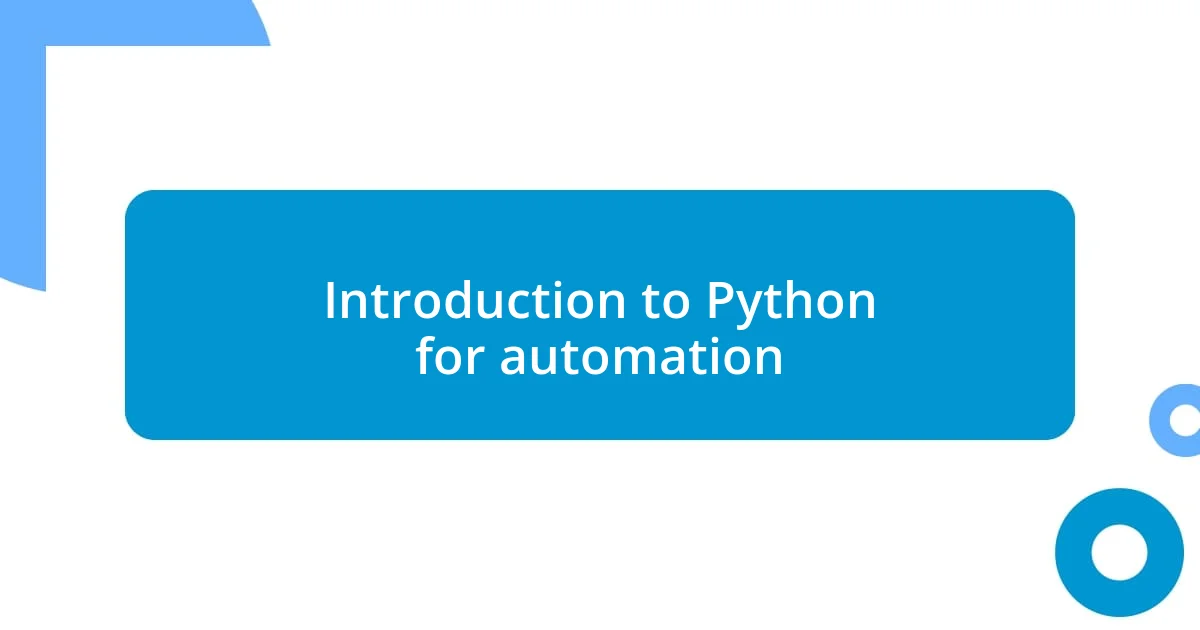
Introduction to Python for automation
Python has become my go-to solution for automation tasks, and I still remember the first time I automated a repetitive process. It felt like magic—what used to take me hours was completed in mere minutes! Really, who doesn’t want to free up time and reduce human error in mundane tasks?
I think one of the most appealing aspects of Python is its simplicity and readability. When I first started programming, I found Python’s syntax so inviting compared to other languages. I often ask myself, how can a language be so powerful yet so straightforward? This balance allows anyone, regardless of their coding experience, to jump in and start automating tasks right away.
As I dove deeper into the world of automation, I discovered a wealth of libraries tailored for various tasks. For instance, I used Selenium for web scraping, and it opened up a whole new dimension for my data collection projects. Isn’t it amazing how a few lines of code can transform the way we interact with technology? This dynamic ability kept me motivated to explore more and more!
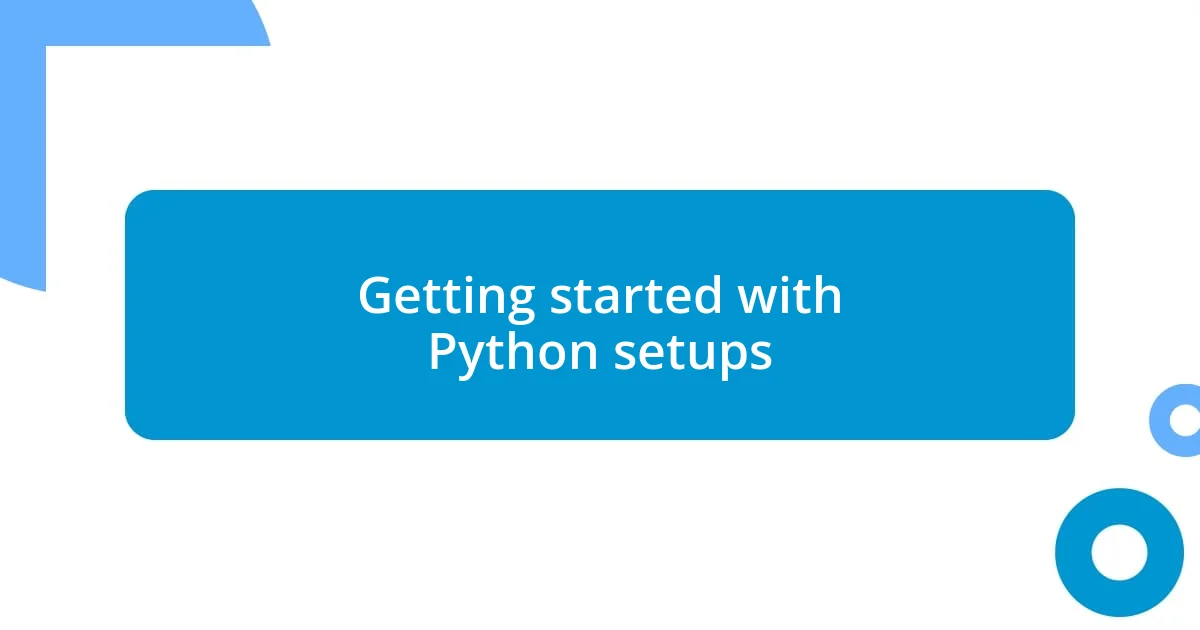
Getting started with Python setups
Getting your Python setup right is essential for a smooth automation experience. I remember my first attempt at installing Python—what a whirlwind that was! I struggled with paths and libraries, and it felt like the universe was against me. It was only after a few missteps that I realized how to easily manage installations with virtual environments. This practice keeps projects organized, allowing for cleaner dependencies and avoiding messy clashes with different libraries.
When I first dabbled in setting up my Python environment, I was confronted with choices—Windows or Linux? Anaconda or plain Python? Each option has its own merits and limitations. I chose to go with Anaconda for its convenience, especially for data science projects, but I still find myself appreciating the lightweight simplicity of a direct Python install for smaller scripts. It’s refreshing to experiment and find what fits best for your unique style of working.
As I navigate various projects, I’ve come to value tools like pip and conda for managing packages. They have saved me countless hours, allowing me to install libraries conveniently. On top of that, the helpful error messages quickly point out what needs fixing. It feels like having a helpful friend guiding you through, which is something I truly appreciated during my learning phase.
| Setup Options | Pros |
|---|---|
| Windows | Familiar interface for most users |
| Linux | Powerful for server-side automation |
| Anaconda | Easy package management and environment setup |
| Plain Python | Lightweight and minimalistic |
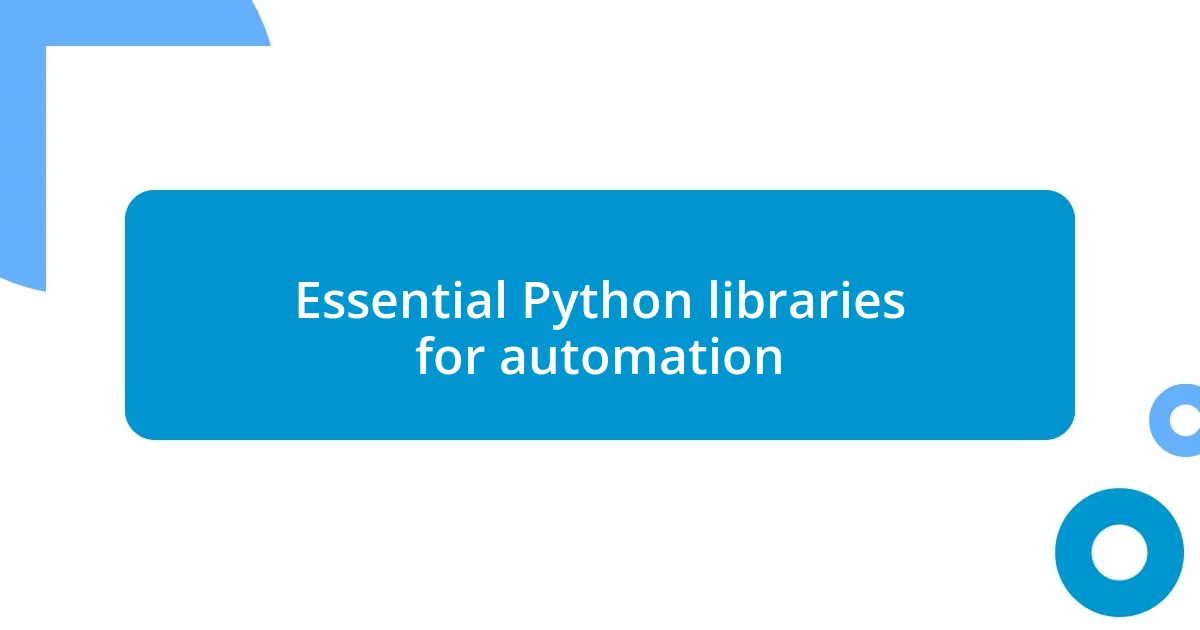
Essential Python libraries for automation
When it comes to automation, leveraging the right Python libraries can truly elevate your projects. I cannot stress enough how much I relied on libraries like Pandas and PyAutoGUI during my automation journey. Pandas makes data manipulation so seamless that I felt like a data wizard, transforming mess into clarity at the click of a button. Meanwhile, PyAutoGUI allowed me to interact with my desktop applications directly. I recall the thrill of watching my script effortlessly navigate through my computer, automating those repetitive clicks I used to dread.
Here’s a quick look at some essential libraries that enhanced my automation experience:
- Selenium: Perfect for web automation and scraping; it mimics human browsing behavior.
- Requests: Wonderful for making HTTP requests; I often used it to gather data from APIs.
- Beautiful Soup: This library pairs well with Requests, allowing easy parsing of HTML and XML documents.
- Pandas: A powerhouse for data manipulation; it allows for clean data management in automation tasks.
- PyAutoGUI: For automating GUI tasks on your desktop; this one felt like having a virtual assistant!
- Schedule: An incredible tool for running your scripts at specified times; I’ve set up many automated reports with its help.
Diving deeper into these libraries not only refined my automation skills but also opened doors to more advanced projects. It’s like having a toolbox filled with everything I need, which gives me the confidence to tackle even complicated automation challenges.
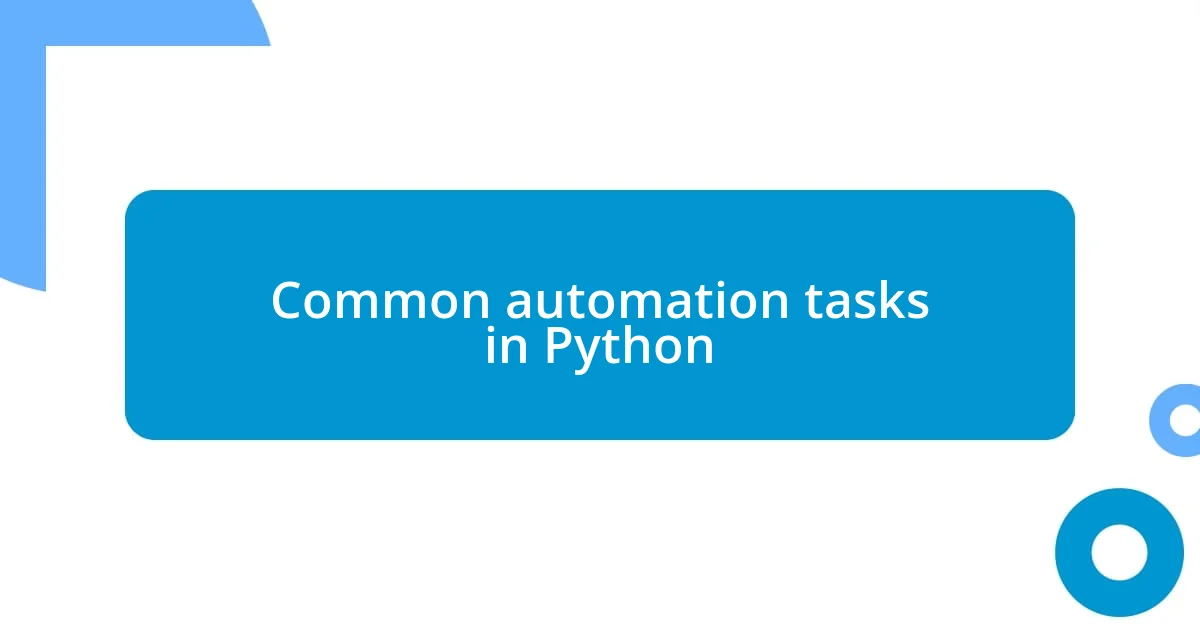
Common automation tasks in Python
Many common automation tasks in Python revolve around streamlining repetitive processes, and I’ve found this truly transformative. For instance, automating data entry into spreadsheets is one of those tasks that once seemed mundane but is now a breeze thanks to libraries like openpyxl. The first time I set up a script to populate an Excel sheet automatically, I couldn’t help but smile at how much time it saved me. Have you ever felt that relief when a monotonous task is handled with a few lines of code?
Another common task is web scraping, which I initially approached with a mix of excitement and trepidation. Using Selenium, I could extract data from websites with relative ease, and I recall the rush I felt when I successfully grabbed a whole bunch of sales data from a pivot table that would have taken hours to compile manually. The beauty of it is that this script can run whenever I need updated data—it’s like having a digital assistant that works in the background while I focus on more creative aspects of my project.
Scheduling scripts to run at specific times is another essential part of automation. I remember setting up an automated email report that delivered insights right to my inbox at 9 AM every Monday. With the schedule library, I felt like I had cracked the code to consistency in my work routine. It’s a little victory each time I see that email pop up, and it makes me wonder—how much more could I automate to free up my time for more interesting challenges? Embracing these tasks has not only made my workflow smoother but has also empowered me to explore even more sophisticated automation possibilities.
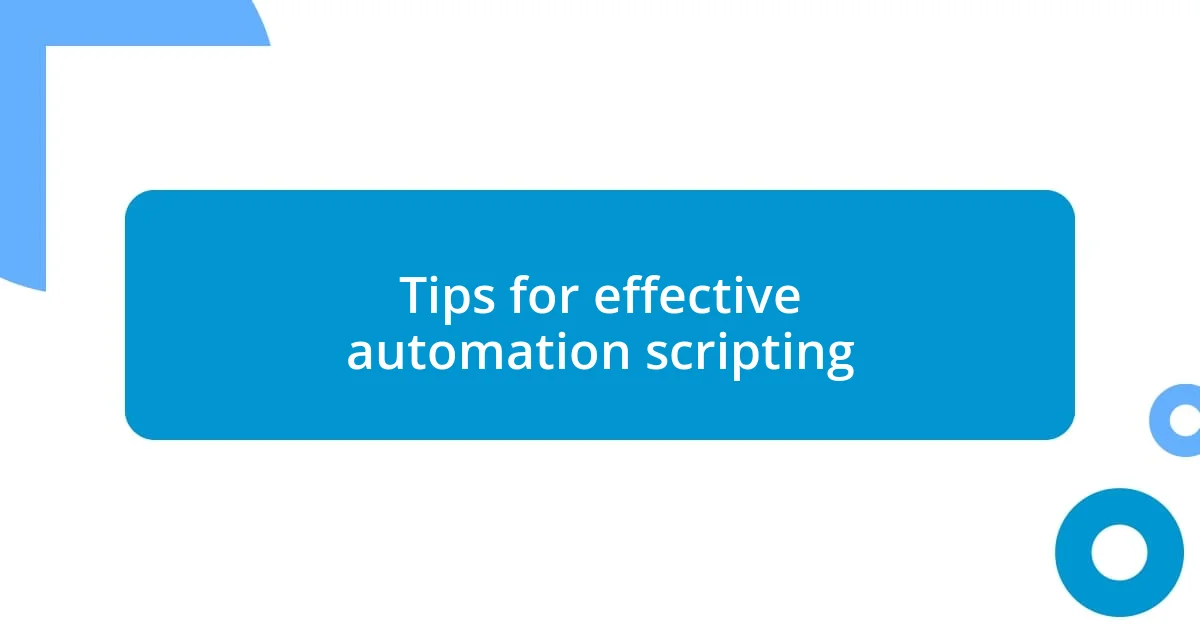
Tips for effective automation scripting
When scripting for automation, clarity is key. I always start by writing clear and concise comments within my code. This not only helps me understand my own thought process when I revisit scripts later, but it also facilitates collaboration if someone else needs to pick up where I left off. Have you ever stumbled upon a perfectly working script but had no idea what it was doing? Trust me, investing time in comments pays off in the long run.
Another crucial tip is to break down your automation tasks into smaller, manageable chunks. When I began automating a multi-step process, I quickly learned that tackling it step-by-step made everything far less overwhelming. For instance, I first focused on automating data collection before moving on to the analysis phase. This incremental approach prevented me from feeling lost in the complexity, allowing me to celebrate small victories along the way. Does this resonate with your experience when approaching difficult projects?
Lastly, I can’t emphasize enough the importance of error handling. Early in my scripting journey, I learned the hard way that overlooking potential errors could lead to a crash, ruining my automation efforts. Since then, I’ve implemented try and except blocks in my scripts. This way, when something goes wrong, I not only get a helpful error message but also avoid complete failure. Doesn’t it feel reassuring to have a safety net in place while you explore the world of automation? It’s these small strategies that make a significant difference in my scripting effectiveness.
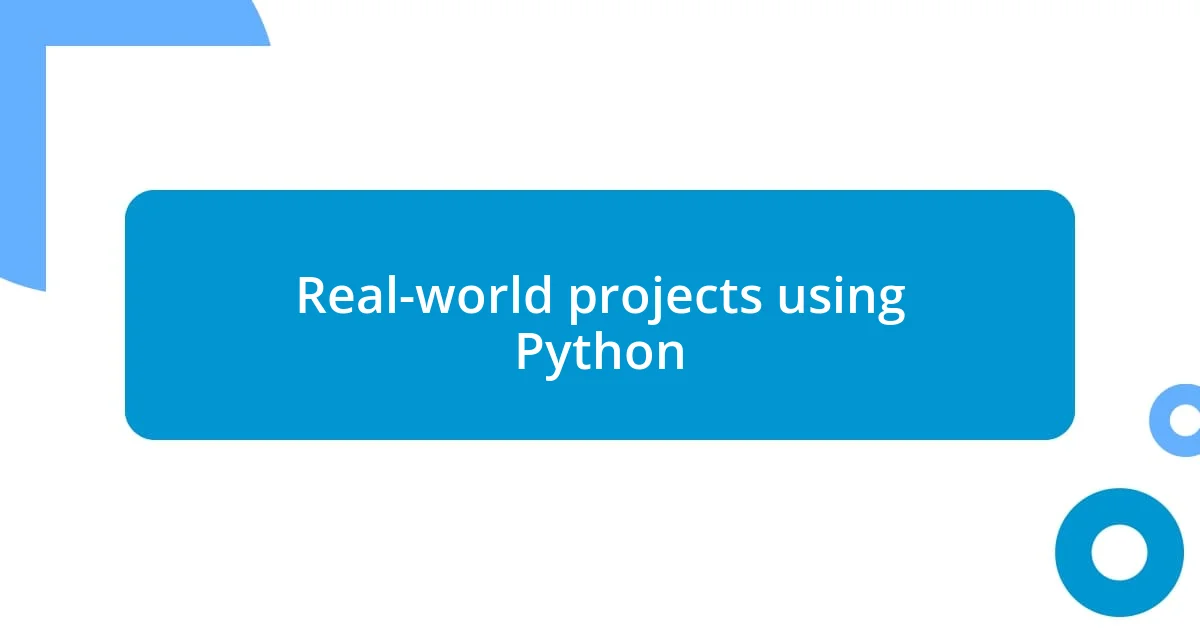
Real-world projects using Python
One of the most rewarding projects I undertook with Python was developing a personal finance tracker. By utilizing Pandas, I could automate the consolidation of my banking transactions and categorize them effortlessly. When I first saw my expenses automatically updated in graphical format each month, I felt a rush of control over my finances that I hadn’t experienced before. Have you ever had a moment when technology truly empowered you?
I’ve also explored automating email responses for a small side business I run. Using the smtplib library, I set up a system that automatically replies to common inquiries. The first time I received positive feedback about the promptness of my replies, I couldn’t help but grin. Isn’t it fascinating how a few lines of code can enhance customer satisfaction so significantly?
I ventured into automating my blog updates, which allowed me to keep content flowing without constant manual intervention. Leveraging the requests library, I could schedule posts and gather feedback from readers on social media without lifting a finger. The thrill of seeing my content reach audiences while I focused on writing new pieces was invigorating. When have you felt that electrifying rush of seeing your work out there without the tedious overhead?














